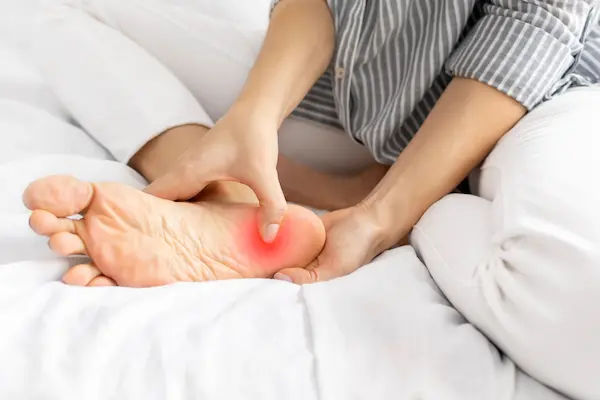What Is Plantar Fasciitis?
Awareness of plantar fasciitis can help take precautions and avoid its severe consequences in the long run. Learn all about it to take the right steps—from assessing symptoms to opting for the right treatment method.

Written by
Last updated on 3rd Jul, 2025
Plantar fasciitis is a condition that causes discomfort, primarily in the bottom of the heel. The plantar fascia is a thick band of tissue that connects the heel to the front of the foot. It plays a crucial role in supporting the arch and absorbing shock during walking. However, when this ligament experiences repeated strain or pressure, it can become inflamed, leading to pain and stiffness, especially in the heel area.
Let us explore the causes and risk factors of plantar fasciitis, as well as its symptoms, diagnostic methods, and available treatment options to help manage the condition better.
Causes and Risk Factors
A variety of factors and activities can contribute to this condition by overloading or weakening the ligament, leading to inflammation and discomfort. Common causes include:
Skipping proper stretching or warm-up routines before physical activity.
High-impact activities, such as running, jumping, or participating in sports.
Exercising, working, or standing on hard surfaces.
Wearing shoes that lack adequate arch support or cushioning.
Standing or walking barefoot for extended periods.
Plantar fasciitis is most common in people aged 40 to 60. Also, individuals with physically demanding jobs that require prolonged standing or walking may be at risk of plantar fasciitis. Individuals with a body mass index (BMI) over 30 or reduced ankle flexibility are also at higher risk, as these factors place additional strain on the plantar fascia.
Symptoms of Plantar Fasciitis
Plantar fasciitis often presents with a range of symptoms that primarily affect the heel and arch of the foot. Some of them are:
A sharp or throbbing pain at the bottom of the heel
Discomfort that extends along the arch of the foot
A feeling of tightness or reduced flexibility in the foot
Mild to moderate swelling around the heel
Tension or tightness in the Achilles tendon
Diagnosis of Plantar Fasciitis
Plantar fasciitis is diagnosed through a medical history review and a physical exam. During the exam, the healthcare provider checks for tender areas in the foot. The pain's location helps identify the cause.
In most cases, imaging tests are not necessary. However, an X-ray or MRI may be recommended to rule out other conditions, such as stress fractures, that could be causing similar symptoms. Occasionally, an X-ray may reveal a bone spur—a bony growth on the heel bone.
While these spurs were once thought to cause heel pain, research has shown that many individuals with bone spurs experience no discomfort, and surgical removal is rarely needed.
Treatment Options
There is no single treatment that cures plantar fasciitis instantly. Initial treatments often include:
Rest
Applying ice
Using anti-inflammatory medications like NSAIDs
Lidocaine patches to reduce pain and swelling.
For persistent pain, a doctor may recommend a corticosteroid injection directly into the affected area of the ligament. While effective, these injections usually provide only short-term relief, particularly for chronic or severe cases.
Other treatments may involve:
Wearing night splints, braces, or supportive footwear to relieve pressure on the plantar fascia.
Additional options like stretches, essential oils, CBD products, or nutritional adjustments may also help manage symptoms.
There are some advanced treatments available, too. These include:
Extracorporeal shockwave therapy
Botox injections
Platelet-rich plasma injections
Dextrose prolotherapy.
These therapies are typically used when conventional treatments fail to provide relief.
Physical Therapy and Exercise
Effective exercises for plantar fasciitis focus on stretching the plantar fascia to reduce strain and improve support. Below are some stretches and strengthening exercises for better management:
1. Stretching Techniques
Some stretching techniques include:
Plantar Fascia Stretch
Calf Stretch
Towel Stretch
Foot Rolling
2. Strengthening Exercises
Here are some strengthening exercises that may help:
Toe Curls
Marble Pick-Up
Heel Raises
Arch Doming
Preventing Plantar Fasciitis
Prevention of plantar fasciitis involves adopting habits that reduce stress on the feet and promote overall foot health. Here are key prevention tips:
Select supportive shoes: Select shoes with good arch support, cushioning, and a proper fit. Avoid walking barefoot on hard surfaces.
Stretch regularly: Incorporate calf, Achilles, and plantar fascia stretches to improve flexibility and reduce tension on the foot.
Maintain a healthy weight: More weight puts additional pressure on the feet. This pressure increases the risk of plantar fasciitis. Regular exercise and a balanced diet help maintain a healthy weight.
Avoid overuse: Gradually increase activity levels, especially with high-impact exercises like running. Include rest days to allow the feet to recover.
Use orthotics: Consider custom or over-the-counter shoe inserts if an individual has flat feet or other structural issues, as they help provide added support and cushioning.
Complications and Prognosis
While most cases of plantar fasciitis improve with treatment, some may lead to complications if left untreated or mismanaged:
Chronic pain: If not addressed, plantar fasciitis can become chronic, leading to long-term pain and limited mobility.
Heel spurs: Persistent inflammation of the plantar fascia can result in the formation of heel spurs—bony growths that may exacerbate pain.
Altered gait: To avoid foot pain, individuals may change the way they walk, potentially causing strain on other joints like the knees, hips, or lower back.
Tendonitis: Inflammation of the Achilles tendon or other foot tendons can occur if the condition worsens or is not properly managed.
The outlook for plantar fasciitis is generally positive, with most people experiencing improvement within 6–12 months with proper treatment. Early intervention, including stretching, strengthening, and appropriate footwear, significantly reduces the risk of long-term issues.
In severe or persistent cases, additional treatments such as corticosteroid injections, physical therapy, or surgery may be required, but these are usually considered as a last resort.
Recent Research and Developments
Recent research into plantar fasciitis has highlighted advancements in treatment and understanding of the condition:
Manual therapy and exercise: Combining manual therapy with targeted exercises has proven effective in reducing pain and improving function for individuals with plantar fasciitis.
Self-stretching and foam rolling: Self-management strategies like stretching and foam rolling have been shown to alleviate pain and improve foot mobility.
Low-Level Laser Therapy (LLLT): While promising, further studies are needed to confirm the effectiveness of LLLT in treating plantar fasciitis.
Stepwise treatment approaches: New guidelines advocate for a gradual treatment plan, starting with conservative methods and advancing if necessary.
Conclusion
Plantar fasciitis is a common but manageable condition that can significantly impact daily activities. Understanding its causes, recognising the symptoms, and seeking an early diagnosis can help prevent long-term complications.
With a variety of treatment options available—ranging from rest and medications to physical therapy and advanced therapies—most individuals can find relief and improve their foot health. By adopting preventive measures such as wearing supportive shoes, maintaining a healthy weight, and regularly stretching, plantar fasciitis can be prevented.
While the journey to recovery may take time, with proper care and attention, most people can successfully manage the condition and regain mobility.
Consult Top General Physicians
Get Your Symptoms Checked

Dr. Vivek D
General Physician
4 Years • MBBS
Bengaluru
PRESTIGE SHANTHINIKETAN - SOCIETY CLINIC, Bengaluru

Dr Syed Mateen Pasha
General Physician
2 Years • MBBS
Bengaluru
PRESTIGE SHANTHINIKETAN - SOCIETY CLINIC, Bengaluru

Dr. Harshendra Jaiswal
General Physician/ Internal Medicine Specialist
12 Years • MBBS , MD (General medicine)
Kolkata
108 DHANA DHANVANTARI Clinic, Kolkata
(25+ Patients)

Dr. Syed Ismail Ali
General Practitioner
7 Years • MBBS
Hyderabad
Apollo 24|7 Clinic, Hyderabad
Dr. Thandra Ramoji Babu
General Physician/ Internal Medicine Specialist
5 Years • MBBS, DNB(General Medicine)
Warangal
Sai Ram multi-specialty hospital, Warangal
Consult Top General Physicians

Dr. Vivek D
General Physician
4 Years • MBBS
Bengaluru
PRESTIGE SHANTHINIKETAN - SOCIETY CLINIC, Bengaluru

Dr Syed Mateen Pasha
General Physician
2 Years • MBBS
Bengaluru
PRESTIGE SHANTHINIKETAN - SOCIETY CLINIC, Bengaluru

Dr. Harshendra Jaiswal
General Physician/ Internal Medicine Specialist
12 Years • MBBS , MD (General medicine)
Kolkata
108 DHANA DHANVANTARI Clinic, Kolkata
(25+ Patients)

Dr. Syed Ismail Ali
General Practitioner
7 Years • MBBS
Hyderabad
Apollo 24|7 Clinic, Hyderabad
Dr. Thandra Ramoji Babu
General Physician/ Internal Medicine Specialist
5 Years • MBBS, DNB(General Medicine)
Warangal
Sai Ram multi-specialty hospital, Warangal
